Abstract
This study aimed to reduce the environmental impact of rapeseed straw accumulation and explore its engineering potential by examining how straw affects the mechanical properties of cement–sand composites. Experiments were conducted using varying straw dosages and curing ages to assess water consumption, setting time, flexural and compressive strengths, pore characteristics (via mercury intrusion), hydration products, and microstructures (via thermogravimetry and X-ray diffraction). Results showed that flexural and compressive strengths decreased with higher straw content, most notably up to 2%, but increased with age due to straw’s water absorption, which altered cement hydration and porosity. Over time, enhanced hydration and pore filling improved strength. This research supports straw’s use in civil engineering and advances eco-friendly concrete material development.
1. Introduction
China, a large agricultural nation, possesses abundant straw resources, with a theoretical annual output reaching up to 7159 × 104 tons [1]. Nevertheless, the current comprehensive utilization level of straw resources remains inadequate, and the phenomena of regional, seasonal, and structural surpluses are conspicuous [2]. The prevalent methods for straw treatment encompass incineration, field return, feed and fertilizer production, etc. However, these straw treatment procedures also entail corresponding drawbacks. Specifically, incineration generates a substantial amount of noxious gases and dust, thereby endangering people’s physical and mental health [3]. In the context of the national ‘pollution prevention and control’ campaign, most regions currently adopt the approach of straw field return to handle field straw. However, this method suffers from a long degradation period that impacts seed germination and an increase in pests and diseases that affects crop yields [4]. The economic returns of feed and fertilizer production are meager and the treatment efficiency is low [5].
Simultaneously, China’s cement industry holds a crucial position in the national economic framework, and its cement production volume tops the global ranking [6]. Accordingly, a number of scholars have made attempts to substitute a portion of cement with straw for the sake of diminishing the demand for cement. Initial investigations were centered on probing the potential of replacing a fraction of cement with straw. Consequently, some scholars have attempted to use straw to replace part of the cement so as to reduce the demand for cement [7,8,9,10,11,12]. Initial studies focused on exploring the feasibility of using straw to replace part of the cement. Some scholars found that when straw was incorporated into cement paste, the overall strength would be reduced, and when the straw content was ensured, the reduction in strength could be acceptable [13]. The incorporation of straw could effectively enhance the thermal insulation capacity of concrete, and the seismic capacity of cement mortar with straw incorporated was improved [14,15,16,17,18,19,20]. Subsequently, a large number of studies shifted to improving the strength of straw concrete. For example, rape straw ash was added to concrete, and through measuring the splitting tensile performance, the optimal mix ratio was determined to improve the tensile performance of concrete [21,22,23,24,25,26]. Nevertheless, the straw-induced attenuation in concrete strength severely restricts the application of straw in concrete. Some studies have demonstrated that the impact of straw on concrete mainly stems from the interaction with cement mortar, whereas the mechanism underlying this effect remains inadequately elucidated. The research on the properties of rapeseed stalk–cement-based materials has predominantly focused solely on mechanical performance, without delving into the underlying causes and mechanisms responsible for changes in mechanical properties. Furthermore, there is limited reporting on the hydration reactions and the evolution of hydration products in rapeseed stalk–cement-based materials.
This study aims to elucidate the mechanistic effects of straw incorporation on the mechanical properties of cement-based composites. Rapeseed straw exhibits remarkable tensile strength and has been widely employed in research pertaining to straw-incorporated concrete [27,28,29]. Thus, the present study, through experimental methodologies, explores the influence mechanism of straw on the mechanical properties of cement mortar for diverse ratios of rapeseed straw–cement mortar mixtures (hereinafter denoted as straw–cement). In this research endeavor, the strength of straw–cement was initially evaluated via compressive and flexural testing. Subsequently, the hydration process of straw–cement was monitored by means of standard consistency water consumption testing and setting time testing. Concurrently, with the assistance of X-ray diffraction analysis, thermogravimetric analysis, and porosity testing, the microstructure and pore characteristics of cementitious sand were examined to dissect the impact of rapeseed straw on the hydration reaction of cementitious sand. Eventually, the influence of rapeseed straw on the strength of cementitious sand was investigated. Ultimately, the mechanism underlying the effect of rapeseed straw on the strength of cementitious sand was elucidated. This study uncovers the influence mechanism of straw on the strength of straw–cement, furnishing theoretical underpinnings and data support for the extensive application of straw in civil engineering and water conservancy projects.
2. Test Content
2.1. Test Materials
The objective of this study is straw–cement, which is formed by the admixture of rapeseed straw and cementitious sand. Physical property tests and chemical property assays were conducted, with the cementitious sand ratio being cement/standard sand/water = 1:3:0.5. PO42.5 ordinary Portland cement (the chemical composition is presented in Table 1), ISO standard sand (ISO standard sand refers to a round silica sand with a SiO2 content of not less than 98%, and its density is 14.9 kg/m2.), pure distilled water, and an Xiangmai oil 763 variety of rapeseed straw were utilized in the tests. The cement used in this study was commercially available Portland cement, stored in a dry environment to prevent moisture absorption. The sand was oven-dried at 110 °C for 24 h to eliminate any moisture and then sieved to ensure a uniform particle size distribution.

Table 1.
Chemical analysis results of the cement (%).
Initially, the rapeseed straw was processed into strips with a length ranging from 5 to 10 mm, and the white flocculent substances within the straw were removed to enhance the bonding efficacy between the rapeseed straw and the viscous substrate. Subsequently, the rapeseed straw strips were immersed in a 2% NaOH solution for 24 h to eliminate lignin, degrade hemicellulose, and modify the crystalline structure of cellulose, thereby improving the accessibility and utilization rate of cellulose [30,31]. Eventually, the rapeseed straw was washed and dried in an oven to obtain the straw samples required for the experiment, as depicted in Figure 1.
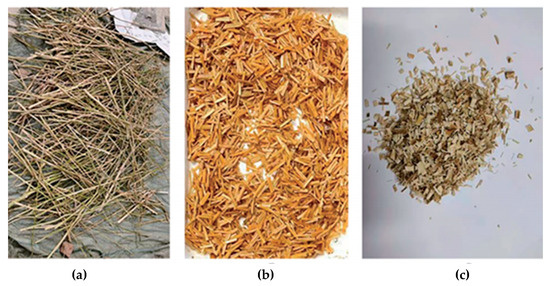
Figure 1.
Straw treatment: (a) raw straw material; (b) straw after washing; (c) treated straw.
2.2. Test Program
The cement mortar was mixed using a mixer, with water added first, followed by rapeseed straw fibers and cement. The mixing bowl was fixed and raised to the mixing position. The machine was operated at low speed for 30 s, followed by gradual addition of standard sand over the next 30 s. After stopping for 90 s to scrape unmixed mortar from the bowl walls, the machine was restarted and run at high speed for 60 s.
The mortar was then molded in two layers, with 300 g per slot, leveled with a large scraper, and vibrated 60 times. The second layer was added, leveled with a small scraper, and excess mortar was removed with a metal straightedge. The molds were labeled, cured in a chamber at 90% humidity and 20 °C, and demolded to produce 40 × 40 × 160 mm test blocks.
In this study, the hydration process, flexural and compressive strengths, pore characteristics, and hydration product characteristics of straw cement were determined. Firstly, according to the specification ASTM C187-23 ‘Standard Test Method For Amount Of Water Required For Normal Consistency Of Hydraulic Cement Paste’ [32], the standard consistency water consumption and the setting time of straw cement were determined by using a standard consistency Vickers meter from Hebei Jingwei; then, the standard consistency water consumption and the setting time of straw cement were determined by using the standard consistency test machine Jinan Hengruijin Micromachine YAW-300D, and the test method of cement compression-folding strength (ISO method) [33] and a folding tester were used to determine the compressive and flexural strength of straw cement. Finally, the crushed straw cement fragments with a particle size of less than 15 mm were selected, and their pore space was measured by a Mike AutoPoreIV9500 mercury piezometer. The porosity and pore characteristics were measured measured using the Mack AutoPore IV9500 Mercury Piezometer; manufactured in the United States. Subsequently, thermogravimetric analysis and X-ray diffraction tests were performed using the Mettler Toledo thermogravimetric analyzer, produced in Switzerland, and the Shimadzu XRD-6000 X-ray diffractometer, manufactured in Japan.
3. Test Results and Analysis
3.1. Analysis of Standard Consistency Water Consumption and Setting Time
The magnitude of standard consistency water consumption directly influences the construction performance of concrete and mortar, such as its workability and pumpability. The relationship curves of the standard consistency water consumption and setting time of straw–cement with diverse dosages are illustrated in Figure 2. As the straw dosage escalates, the standard consistency water consumption of straw–cement rises linearly owing to the potent water-absorbing capacity of straw that has been treated with 2% NaOH solution and dried. Moreover, the high cellulose content in straw, which is a hydrophilic substance, can continuously adsorb water, resulting in a remarkable reduction in the initial setting time and final setting time of straw–cement with the augmentation of straw. With the addition of straw, the free water surrounding the cement and sand diminishes, the cementitious sand and straw rapidly agglomerate into flocs [34], the slurry density escalates, and the setting time is curtailed.
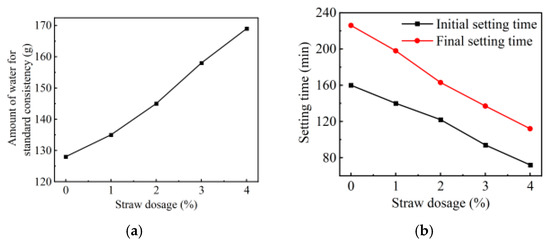
Figure 2.
Cement performance between different straw fiber ratio: (a) effect of ratio on water requirement of standard consistency; (b) effect of fiber ratio on setting time.
3.2. Analysis of Flexural and Compressive Strength
The strength of cement mortar typically comprises two constituents, namely compressive and flexural components. Consequently, Figure 3 depicts the compressive and flexural strengths of straw–cement. As illustrated in Figure 3a, upon comparing the distinct curves, the flexural strength of straw–cement progressively augments with the increment of curing age. From an individual curve perspective, the flexural strength of straw–cement diminishes as the straw admixture dosage escalates, and there exists a threshold value of 2% for such variation: the flexural strength of straw–cement experiences a rapid decline when the straw admixture dosage is augmented from 0% to 2%, and the strength remains essentially invariant when the dosage ranges from 2% to 4%. Figure 3b summarizes the compressive strength of straw–cement at diverse dosages and curing ages. Analogous to the flexural strength, the compressive strength of straw–cement escalates with age, and the elevation in straw admixture dosage leads to a reduction in the compressive strength of straw–cement, although no conspicuous threshold was detected.
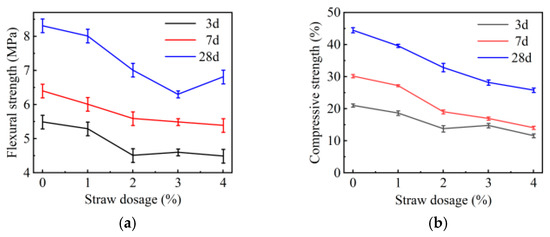
Figure 3.
Effect of straw on the strength of cement mortar: (a) effect of straw on bending strength; (b) effect of straw on compressive strength.
The flexural–compressive ratio is conventionally employed as an index for appraising the toughness of materials [35]. Figure 4 presents the flexural–compressive ratios of different straw–cements. With the augmentation of straw admixture dosage, the flexural–compressive ratio of straw–cements increases, thereby indicating that the addition of straw can enhance the toughness of straw–cements. By comparing the different curves, it can be observed that the increment in age results in a decrease in the flexural–compressive ratio of straw–cement. The variation in the flexural–compressive ratio of 3% and 4% dosages at 3 d and 7 d is not pronounced, whereas the 28 d flexural–compressive ratio exhibits a significant alteration. The rationale is that the principal moisture in the straw–cement migrates and a portion of the water is gradually released, leading to an unobvious change in the flexural–compressive ratio of the initial stage of the straw–cement. This implies that straw–cement necessitates a more extended curing period.
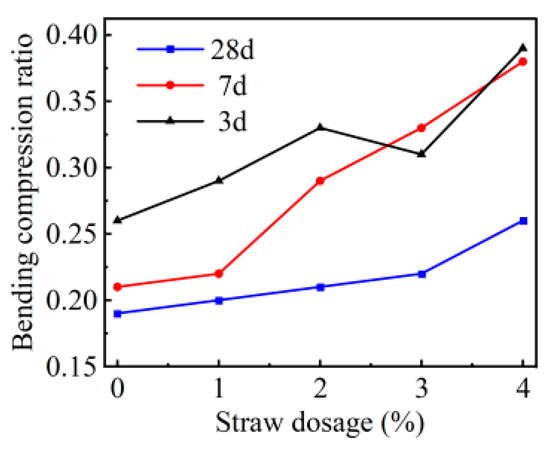
Figure 4.
Effect of straw on the flexural and compressive strength of cement mortar.
3.3. Pore Characterization
Pore characteristics usually affect the strength and durability of concrete; therefore, Figure 5 demonstrates the porosity of different straw cements and the percentage of different pore size distributions. Figure 5a shows the effect of straw admixture on the porosity of straw cement. Comparing the different curves, the porosity of straw cement increases gradually with the increase in straw dosage. Comparing the single curve with 1–2% dosage, the porosity of straw cement increases rapidly, and with 3–4% dosage the porosity of straw cement still has a certain decreasing tendency and then increases again; with the increase in age, the porosity of straw cement decreases significantly. Figure 5b shows the effect of straw dosage on the percentage of pore size distribution of straw cement. For the effect of different pore sizes on concrete properties, they were classified according to the pore size as follows: harmless pores (<20 nm), less harmful pores (20–100 nm), harmful pores (100–200 nm), and more harmful pores (>200 nm) [36]. With the increase in straw dosing, the percentage of less harmful and harmful pores of straw cement gradually increased, while the percentage of harmless pores gradually decreased. The effect of straw on the porosity and pore characteristics of straw cement at constant dosages was that the porosity of straw cement gradually decreased with increasing age. The main reason is that the hydration reaction of cement continues, the hydration products generated inside the cement fill the internal pores, and the crystals keep growing, which makes the porosity of straw cement decrease. However, when the age is constant, the porosity of straw cement increases with the increase in straw dosing. The main reason for this is that the incorporation of straw affects the standard consistency water consumption and setting time of straw cement, which in turn affects the hydration reaction of the cement, resulting in the hydration products not being able to completely fill the internal pores of straw cement.
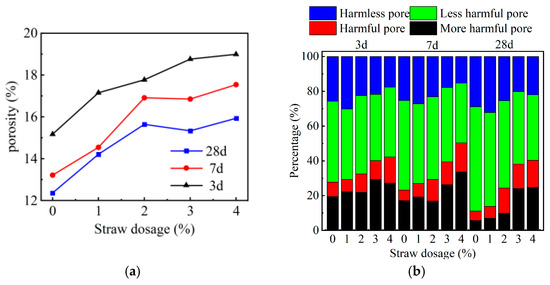
Figure 5.
Porosity and cumulative aperture distribution of different fiber ratios and curing times: (a) effect of straw fiber ratio on porosity; (b) effect of fiber ratio on cumulative distribution.
3.4. Analysis of Hydration Products
3.4.1. Thermogravimetric Test Analysis
The thermogravimetric analysis (TGA) offers a direct and visual approach to monitor the hydration kinetics of cement and the evolution of hydration products. Figure 6 delineates the impact of varying straw dosages on the quantity of substances formed during the cement hydration process. A notable decline in the concentrations of AFt (ettringite) and C-S-H (calcium silicate hydrate) is evident as the straw dosage escalates. In contrast, a marginal increment in Ca(OH)2 (portlandite) content is discernible at 1% and 2% straw dosages. Relative to the control cement sample, the augmented formation of hydration products, including C-S-H, AFt, and Ca(OH)2, underpins the stability of the straw–cement composites, diminishes porosity, and consequently fortifies the material’s strength. At a 1% straw dosage, despite the reduction in C-S-H and AFt alongside an uptick in Ca(OH)2, the thermogravimetric profile closely mirrors that of the 0% dosage, with analogous trends in porosity and mechanical strength. The CaCO3 content exhibits a decrement upon increasing the straw dosage to 2%, followed by an increment at 3% and 4% dosages. This pattern suggests that straw incorporation at lower levels bolsters the carbonation resistance of the cementitious matrix, although this effect is attenuated with higher straw incorporations, indicating a dosage-dependent efficacy in enhancing carbonation resistance.
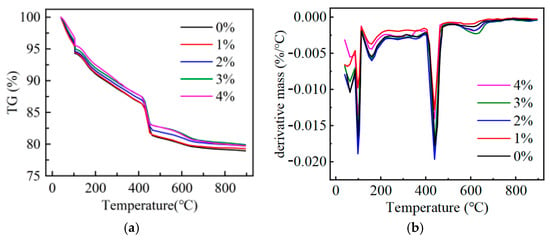
Figure 6.
Effect of straw content on thermogravimetry of hydration products: (a) TG curve; (b) DTG curve.
Figure 7 illustrates the influence of curing age on the formation of hydration products in cement containing 1% straw. A comparison of the thermogravimetric curves reveals that the heat absorption peaks of the 1% straw-doped cement exhibit similar patterns across different curing ages. Specifically, at 3 days of curing, the dehydration of C-S-H gel accounts for 8.89%, while the decomposition rates of Ca(OH)2 and CaCO3 are 4.36% and 1.06%, respectively. By 7 days, the dehydration percentage of C-S-H gel increases to 10.52%, with Ca(OH)2 and CaCO3 decomposition rates rising to 5.58% and 1.44%, respectively. At 28 days, the C-S-H gel dehydration further increases to 13.43%, accompanied by Ca(OH)2 and CaCO3 decomposition rates of 5.96% and 1.4%, respectively. These results demonstrate a progressive increase in the formation of hydration products over time, highlighting the ongoing hydration process in the straw-doped cement system.
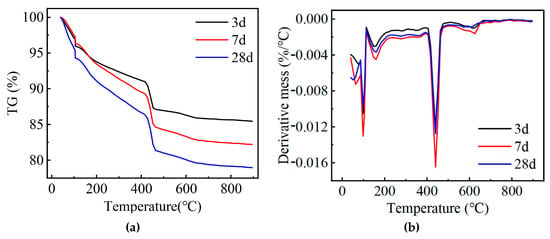
Figure 7.
Effect of straw fiber ratio on the TG of hydration products: (a) TG curve; (b) DTG curve.
3.4.2. X-Ray Diffraction Test Analysis
X-ray diffraction is typically employed for physical phase analysis, crystal structure analysis, and microstructure investigation of cement during the hydration reaction process. Accordingly, Figure 8 illustrates the impact of different straw dosages on the structure of cement hydration products. Figure 8a depicts the effect of straw dosage on the structure of cement hydration products. Unreacted C2S was present in all the samples at the curing age of 28 days. At 3% and 4% dosages, the diffraction peaks of C2S were more prominent, indicating a greater amount of unreacted C2S, signifying that the presence of straw influenced the hydration reaction of C2S. No distinct C3S diffraction peaks were detected in all the samples, suggesting that the reaction of C3S was relatively complete and that the straw had a minimal effect on the hydration reaction of C3S. No conspicuous AFt diffraction peaks were observed in any of the samples. The diffraction peaks of hydration products indicated the presence of Ca(OH)2, and the intensity of the diffraction peaks of Ca(OH)2 in cements with different straw dosages did not exhibit any significant disparity, implying that there was no substantial difference in the structure of hydration products of cements with different straw dosages. However, the peaks of the diffraction peaks were slightly attenuated at 3% and 4% dosages, which was due to the influence of straw on the hydration reaction of C2S. It should be noted that the Ca(OH)2 generated by the hydration reaction of cement primarily stems from the hydration reaction of C3S. The diffraction peaks of C-S-H emerged in the X-ray diffractograms of all the samples, and C-S-H is also one of the typical products of the cement hydration reaction, with the diffraction peaks of C-S-H in each sample not demonstrating any evident differences. In summary, the influence of straw on the hydration reaction of cement was principally centered on its effect on C2S, while the generation of Ca(OH)2 was accompanied by a slight effect.
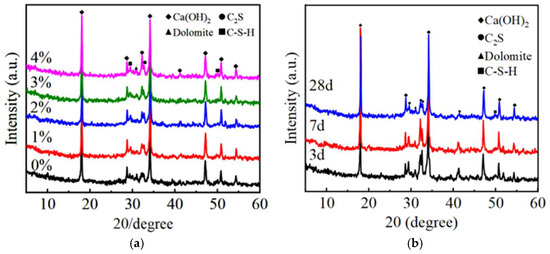
Figure 8.
XRD of straw fiber cement purification slurry: (a) XRD with different fiber ratios; (b) XRD of 1% straw admixture at different ages.
We also tested the influence of the pretreatment of rice straw on the hydration of straw fiber-filled cement-based composites. An increasing trend in Ca(OH)2 content during the early hydration stage has been reported, aligning with our observations at 1% and 2% straw dosages. Studies have investigated the effect of straw incorporation on the formation of cement hydration products and found that the content of C-S-H gel decreased with increasing straw dosage, which is consistent with our results. The strength of straw–cement declined following the addition of straw. Concurrently, straw comprises cellulose and lignin. During the mixing process of straw and cementitious sand, an ‘agglomeration’ phenomenon occurs. Straw enwraps a portion of the free water between itself and the cementitious sand, thereby leading to an increase in the standard consistency water consumption of straw–cement and a shortening of the setting time. The standard consistency water consumption and setting time can mirror the hydration reaction process of cement. The presence of straw exerts an inhibitory effect on the hydration reaction of cement. Consequently, the filling of the pores of straw–cement by cement hydration products and the pore distribution are also impeded, thus diminishing the strength of straw–cement. Particularly in the early stage, the impact of straw on compressive strength is more pronounced. With the augmentation of curing age, the amount of cement hydration products rises, the internal pores of straw–cement are filled, and the pore distribution is altered, which in turn modifies its strength characteristics.
4. Conclusions
This study explored the mechanism of straw’s impact on cementitious sand’s mechanical properties by analyzing hydration processes, strength, porosity, and hydration products. The key findings are as follows:
(1) Increasing the straw dosage significantly reduces compressive strength but has a milder effect on flexural strength, raising the compressive–flexural ratio. Strength improves with curing age, though the ratio decreases, indicating straw’s greater influence on early compressive strength.
(2) Straw incorporation increases water demand for standard consistency and shortens setting time due to its high water absorption, disrupting hydration and affecting strength.
(3) TGA and XRD results show that straw incorporation significantly affects cement hydration and hydration product formation. With increasing curing age, the proportion of harmful pores decreases while harmless pores increase, indicating that progressive hydration improves the pore structure and enhances the mechanical properties of straw–cement composites.
(4) Based on the experimental results, this study recommends an optimal straw incorporation of 1% by cement weight for producing lightweight eco-friendly cement composites. The developed material demonstrates significant potential for non-structural applications including partition walls, ceiling panels, and insulation boards. This innovative approach not only addresses sustainable construction needs through agricultural waste utilization and reduced cement consumption but also offers economic advantages for low-cost housing projects, especially in rural areas with abundant straw resources.
The employment of straw can mitigate the environmental pollution caused by agricultural waste and diversify the pathways for the resource utilization of agricultural waste. In this study, the mechanism of straw’s influence on cement strength was analyzed from both macroscopic and microscopic perspectives. In future works, we will develop new straw–cement with high straw content and strength based on the impact of straw on cement strength.
Author Contributions
Conceptualization, B.L. and J.Z.; methodology, L.F.; validation, L.F. and B.L.; formal analysis, F.Z.; investigation, F.Z.; resources, D.H.; data curation, J.Z.; writing—original draft preparation, D.H.; writing—review and editing, D.H. and J.Z.; supervision, L.F.; project administration, B.L.; funding acquisition, B.L., J.Z. and L.F. All authors have read and agreed to the published version of the manuscript.
Funding
This research was funded by the Water Resources Science and Technology Program of Hunan Province, China (XSKJ2023059-45); the Natural Science Foundation project of Hunan Province, China (2023JJ40332 and 2024JJ5208); the Department of Education funded research project of Hunan Province, China (21A0123); and the 2023 Central Agricultural Machinery Research and Development, Manufacturing, Promotion, and Integrated Application Pilot Fund, China Project (Hunan Finance Department’s Pre-(2023) No. 204 Document).
Data Availability Statement
The original contributions presented in the study are included in the article; further inquiries can be directed to the corresponding authors.
Conflicts of Interest
The authors declare no conflicts of interest.
References
- Ren, J.; Yu, P.; Xu, X. Straw Utilization in China—Status and Recommendations. Sustainability 2019, 11, 1762. [Google Scholar] [CrossRef]
- Yang, W.; Li, X.; Zhang, Y. Research Progress and the Development Trend of the Utilization of Crop Straw Biomass Resources in China. Front. Chem. 2022, 10. [Google Scholar] [CrossRef] [PubMed]
- Jiang, D.; An, P.; Cui, S.; Sun, S.; Zhang, J.; Tuo, T. Effect of Modification Methods of Wheat Straw Fibers on Water Absorbency and Mechanical Properties of Wheat Straw Fiber Cement-Based Composites. Adv. Mater. Sci. Eng. 2020, 2020, 5031025. [Google Scholar] [CrossRef]
- Shan, A.; Pan, J.; Kang, K.J.; Pan, M.; Wang, G.; Wang, M.; He, Z.; Yang, X. Effects of straw return with N fertilizer reduction on crop yield, plant diseases and pests and potential heavy metal risk in a Chinese rice paddy: A field study of 2 consecutive wheat-rice cycles. Environ. Pollut. 2021, 288, 117741. [Google Scholar] [CrossRef] [PubMed]
- Seglah, P.A.; Wang, Y.; Wang, H.; Bi, Y. Estimation and Efficient Utilization of Straw Resources in Ghana. Sustainability 2019, 11, 4172. [Google Scholar] [CrossRef]
- Shen, L.; Gao, T.; Zhao, J.; Wang, L.; Wang, L.; Liu, L.; Chen, F.; Xue, J. Factory-level measurements on CO2 emission factors of cement production in China. Renew. Sustain. Energy Rev. 2014, 34, 337–349. [Google Scholar] [CrossRef]
- Chen, J.; Elbashiry, E.M.A.; Yu, T.; Ren, Y.; Guo, Z.; Liu, S. Research progress of wheat straw and rice straw cement-based building materials in China. Mag. Concr. Res. 2018, 70, 84–95. [Google Scholar] [CrossRef]
- Niu, B.; Kim, B.H. Method for Manufacturing Corn Straw Cement-Based Composite and Its Physical Properties. Materials 2022, 15, 3199. [Google Scholar] [CrossRef] [PubMed]
- Petrella, A.; Spasiano, D.; Liuzzi, S.; Ayr, U.; Cosma, P.; Rizzi, V.; Petrella, M.; Di Mundo, R. Use of cellulose fibers from wheat straw for sustainable cement mortars. J. Sustain. Cem.-Based Mater. 2019, 8, 161–179. [Google Scholar] [CrossRef]
- Katman, H.Y.B.; Khai, W.J.; Bheel, N.; Kırgız, M.S.; Kumar, A.; Khatib, J.; Benjeddou, O. Workability, Strength, Modulus of Elasticity, and Permeability Feature of Wheat Straw Ash-Incorporated Hydraulic Cement Concrete. Buildings 2022, 12, 1363. [Google Scholar] [CrossRef]
- Yang, L.; Wang, S.; Yang, L.; Wu, Y.; Liu, Y. Towards net zero carbon buildings: Potential use of gypsum-based highland barley straw concrete in solar energy enrichment area of China. Build. Environ. 2025, 271, 112586. [Google Scholar] [CrossRef]
- Prabhakar, V.; Alam, M.; Wankhade, R.L. Evaluation of strength and modulus of elasticity (Ec) of concrete incorporated with recycled aggregate and rice straw ash (RSA). Constr. Build. Mater. 2024, 448, 138016. [Google Scholar] [CrossRef]
- Li, Y.; Zhu, N.; Chen, J. Straw characteristics and mechanical straw building materials: A review. J. Mater. Sci. 2023, 58, 2361–2380. [Google Scholar] [CrossRef]
- Wu, B.; Zhang, S.; Zhao, Y.; Cui, T.; Xu, Y. Dynamic compressive properties of rubberized mortar reinforced with straw-fiber additive. Constr. Build. Mater. 2023, 408, 133679. [Google Scholar] [CrossRef]
- Farooqi, M.U.; Ali, M. Effect of pre-treatment and content of wheat straw on energy absorption capability of concrete. Constr. Build. Mater. 2019, 224, 572–583. [Google Scholar] [CrossRef]
- Lu, J.-X. Recent advances in high strength lightweight concrete: From development strategies to practical applications. Constr. Build. Mater. 2023, 400, 132905. [Google Scholar] [CrossRef]
- Charai, M.; Mezrhab, A.; Moga, L.; Karkri, M. Hygrothermal, mechanical and durability assessment of vegetable concrete mixes made with Alfa fibers for structural and thermal insulating applications. Constr. Build. Mater. 2022, 335, 127518. [Google Scholar] [CrossRef]
- Zhang, J.; Guo, X.; Tang, X.; A, L. Experimental and numerical simulation of seismic behavior of reinforced concrete frames infilled with refractory straw blocks. Structures 2024, 69, 107475. [Google Scholar] [CrossRef]
- Wu, Z.; Wang, X.; Chen, Z. Experimental study on preparation and performance of the Corn Straw Fiber (CSF) reinforced EPS concrete. J. Build. Eng. 2024, 89, 109378. [Google Scholar] [CrossRef]
- Farooqi, M.U.; Ali, M. Durability evaluation of wheat straw reinforced concrete for sustainable structures. J. Build. Eng. 2024, 82, 108400. [Google Scholar] [CrossRef]
- Lu, X.-y.; Zhao, Z. Effect of Rape Straw Fiber on Mechanical Properties and Microstructure of Fly Ash Concrete. Adv. Civ. Eng. 2022, 2022, 3002430. [Google Scholar] [CrossRef]
- Deng, J.-X.; Li, X.; Li, X.-J.; Wei, T.-B. Analysis of the Performance of Recycled Insulation Concrete and Optimal Mix Ratio Design Based on Orthogonal Testing. Materials 2023, 16, 5688. [Google Scholar] [CrossRef] [PubMed]
- Deng, J.-X.; Li, X.; Li, X.-J.; Wei, T.-B. Research on the Performance of Recycled-Straw Insulating Concrete and Optimization Design of Matching Ratio. Sustainability 2023, 15, 9608. [Google Scholar] [CrossRef]
- Al-mulali, M.Z.; Awang, H.; Abdul Khalil, H.P.S.; Aljoumaily, Z.S. The incorporation of oil palm ash in concrete as a means of recycling: A review. Cem. Concr. Compos. 2015, 55, 129–138. [Google Scholar] [CrossRef]
- Zhao, Y.; Sun, S.; Liu, Y.; Liu, M. Study on performance deterioration and life prediction of reed straw-recycled brick aggregate concrete after freeze-thaw cycle. Case Stud. Constr. Mater. 2024, 21, e03728. [Google Scholar] [CrossRef]
- Wu, B.; Yang, L.; Mei, Y.; Sun, Y.; Shen, J. Dynamic tensile properties of straw fiber reinforced rubber concrete. J. Build. Eng. 2024, 96, 110455. [Google Scholar] [CrossRef]
- Shah, I.; Li, J.; Yang, S.; Zhang, Y.; Anwar, A. Experimental Investigation on the Mechanical Properties of Natural Fiber Reinforced Concrete. J. Renew. Mater. 2021, 10, 1307–1320. [Google Scholar] [CrossRef]
- Farooqi, M.U.; Ali, M. Contribution of plant fibers in improving the behavior and capacity of reinforced concrete for structural applications. Constr. Build. Mater. 2018, 182, 94–107. [Google Scholar] [CrossRef]
- Wang, G.; Han, Y. Research on the Performance of Straw Fiber Concrete. IOP Conf. Ser. Mater. Sci. Eng. 2018, 394, 032080. [Google Scholar] [CrossRef]
- Ashour, T.; Morsy, M.; Korjenic, A.; Fischer, H.; Khalil, M.; Sesto, E.; Orabi, M.; Yehia, I. Engineering Parameters of Rice Straw Concrete with Granulated Blast Furnace Slag. Energies 2021, 14, 343. [Google Scholar] [CrossRef]
- Xie, X.; Gou, G.; Wei, X.; Zhou, Z.; Jiang, M.; Xu, X.; Wang, Z.; Hui, D. Influence of pretreatment of rice straw on hydration of straw fiber filled cement based composites. Constr. Build. Mater. 2016, 113, 449–455. [Google Scholar] [CrossRef]
- ASTM C187-23; Standard Test Method for Amount of Water Required for Normal Consistency of Hydraulic Cement Paste. ASTM International: West Conshohocken, PA, USA, 2023.
- GB/T17671-2021; Test Method of Cement Sand Strength (ISO Method). National Standard of the People’s Republic of China: Beijing, China, 2021.
- He, J.; Sun, C.; Wang, X. Mechanical Properties and Microanalytical Study of Concrete Reinforced with Blended Corn Straw and Scrap Steel Fibers. Materials 2024, 17, 3844. [Google Scholar] [CrossRef] [PubMed]
- Liu, L.; Yang, J.; She, Y.; Lv, S.; Yang, Z.; Zhang, J. Resourceful Utilization of Cow Hair in the Preparation of Iron Tailing-Based Foam Concrete. Materials 2022, 15, 5739. [Google Scholar] [CrossRef] [PubMed]
- Nazari, A.H.; Riahi, S. Effects of CuO Nanoparticles on Microstructure, Physical, Mechanical and Thermal Properties of Self-Compacting Cementitious Composites. J. Mater. Sci. Tech. 2011, 27, 81–92. [Google Scholar] [CrossRef]
Disclaimer/Publisher’s Note: The statements, opinions and data contained in all publications are solely those of the individual author(s) and contributor(s) and not of MDPI and/or the editor(s). MDPI and/or the editor(s) disclaim responsibility for any injury to people or property resulting from any ideas, methods, instructions or products referred to in the content. |
© 2025 by the authors. Licensee MDPI, Basel, Switzerland. This article is an open access article distributed under the terms and conditions of the Creative Commons Attribution (CC BY) license (https://creativecommons.org/licenses/by/4.0/).